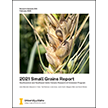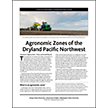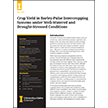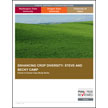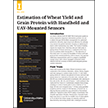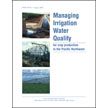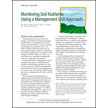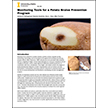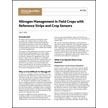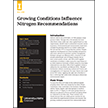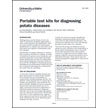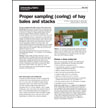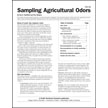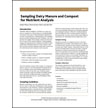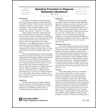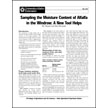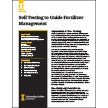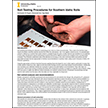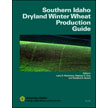On-Farm Testing
2021 Small Grains Report: Southcentral and Southeast Idaho Cereals Research & Extension Program
Packed with tons of agronomic data, disease ratings and end-use quality data — interspersed with reports about planting and weather conditions, insect and diseases issues and more — this 160-page...
2022 Small Grains Report: Southcentral and Southeast Idaho Cereals Research & Extension Program
Packed with tons of agronomic data, disease ratings and end-use quality data — interspersed with reports about planting and weather conditions, insect and diseases issues, and more — this 162-page...
A Grower's Guide to Successful On-Farm Research
Interested in identifying a new crop rotation or adopting a new irrigation method to improve your yield, but worried about the time and money wasted if it doesn't work? Conduct your own on-farm...
Agronomic Zones of the Dryland Pacific Northwest
With an annual wheat harvest valued at $2.1 billion, producers in Idaho, Oregon and Washington know the value of farming practices adapted to each region, county and field. Researchers mapped...
Crop Yield in Barley-Pulse Intercropping Systems under Well-Watered and Drought-Stressed Conditions
Idaho leads the nation in barley production, even though eastern Idaho (the state’s largest contributor) receives very little annual precipitation. Applying shrewd irrigation management practices...
Enhancing Crop Diversity: Steve and Becky Camp (Farmer to Farmer Case Study Series)
Steve and Becky Camp farm near LaCrosse, Washington, in an area receiving about 12-14 inches of annual precipitation. In this publication, the Camps discuss their strategy for diversifying and...
Estimation of Sugar Beet Yield and Quality with UAV-Based Sensors
Efficient nitrogen (N) and water management are key for maximizing sugar yield in sugar beets. UAV-based remote sensing is increasingly being using as a tool for in-season N and water management...
Estimation of Wheat Yield and Grain Protein with Handlheld and UAV-Mounted Sensors
Wheat grain protein levels depend on efficient uptake of nitrogen (N) — without it, optimized wheat yields are not possible. Monitoring your field’s N uptake is thus crucial. Using crop sensors to...
Managing Irrigation Water Quality for Crop Production in the Pacific Northwest
Learn how to use water analyses to choose appropriate water treatment and water management practices in irrigated agriculture. The publication covers kinds of tests, sample collection,...
Monitoring Soil Nutrients Using a Management Unit Approach
This publication focuses on how to design a soil nutrient monitoring strategy using management units or zones for soil testing and nutrient application. The management unit approach is designed to...
Monitoring Tools for a Potato Bruise Prevention Program
Potato bruising is costly. It lowers the quality of a crop, leading to customer rejections or direct waste. It's thus critical to quickly identify what is causing the injuries in your operation.
Nitrogen Management in Field Crops with Reference Strips and Crop Sensors
Learn how crop sensors and reference strips work and how to use them to fine-tune nitrogen (N) fertilizer applications to cut costs and increase revenues and yields. The techniques can be used in...
Nutrient Management Guidelines for Russet Burbank Potatoes
Efficient potato nutrient management systems are designed to ensure that all essential plant nutrients are available in appropriate amounts and at the most beneficial time to provide for optimal...
Optimum Nitrogen Rates for Wheat Depend on the Environment and Field-Specific Conditions
Nitrogen is vital for crops — it is an essential nutrient whose efficient absorption makes high crop yields possible. Despite significant developments in wheat breeding and nutrient management,...
Portable Test Kits for Diagnosing Potato Diseases
University of Idaho scientists evaluated commercially available portable test kits for diagnosing potato diseases, finding them generally accurate and easy to use. This publication discusses the...
Proper Sampling (Coring) of Hay Bales and Stacks
Bad nutrition diminishes any herd's productivity. Forage sampling is thus a key strategy that helps livestock producers to maintain or optimize their operation's output. This four-page bulletin...
Agricultural odors can be quite problematic for livestock producers, particularly when the neighbors begin to complain. Monitoring these unpleasant smells can help producers to gauge their severity...
Sampling Dairy Manure and Compost for Nutrient Analysis
Testing the nutrient content of dairy manure or compost reveals nutrient value and determines the application rate, but it must be done correctly. This six-page guide shows you how to conduct a...
Sampling Procedure to Diagnose Nematode Infestations
Nematodes are tiny wormlike plant pests that in the United States cause an estimated 10% drop in crop values annually. As Integrated Pest Management and Integrated Crop Production methods have...
Sampling the Moisture Content of Alfalfa in the Windrow: A New Tool Helps
Production of high-quality hay is vital for the dairy industry. Because forage moisture content determines its quality, producers need to know how to accurately measure the amount of water in...
Soil Testing to Guide Fertilizer Management
Regularly testing your soil will allow you to accurately spot problem areas and thus provide sustainable soil nutrient management. This updated version of a 1997 bulletin provides the basic...
Soil-Testing Procedures for Southern Idaho Soils
Crops require seventeen nutrients to thrive. To make sure your soil is providing them, soil sampling and testing are critical. This bulletin provides a brief overview of both by discussing how...
Southern Idaho Dryland Winter Wheat Production Guide
Wheat is an important crop throughout Idaho, especially in the dryland cropping areas of southern Idaho. However, the region's rolling landscape with high-wind and water-erosion potential plus low...








